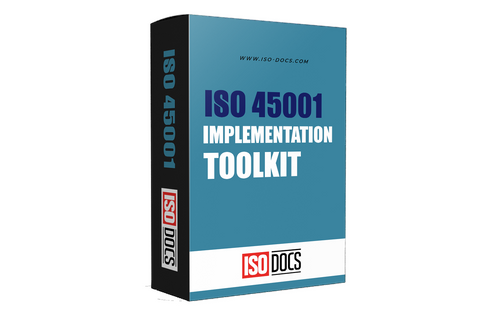ISO 45001 Audit Forms Download
Introduction: The Importance of ISO 45001 Audits And Audit Forms
ISO 45001 is an important standard that focuses on occupational health and safety management systems, which creates a safe work environment. By implementing ISO 45001, organizations can identify and mitigate risk, which will ensure the well-being of employees. Regular audits play an important role in maintaining compliance with this standard, which helps organizations to achieve safety practices and identify areas for improvement.
The Role Of Audits In Maintaining Compliance
An audit plays an important role in meeting the requirements of ISO 45001. They provide a systematic approach to evaluate safety measures taken in an organization, ensuring the policy and procedures are effectively implemented. Through audits, organizations can identify non-conformities and take corrective actions, adopting the culture of continuous improvement in workplace safety.
Using Audit Forms For Efficient And Effective Audits
To ensure the smooth running of the audit process, making use of audit forms is highly beneficial. These forms serve as a structured template that guides auditors through the evaluation phase, ensuring that all necessary aspects are covered. By downloading ISO 45001 forms, organizations can streamline their audit preparations, making the process more organized and thorough. It not only saves time but also keeps the overall quality of the audit.

Downloadable ISO 45001 Audit Forms And Templates
When it comes to ensuring workplace safety, having the right tools is essential. Downloadable ISO 45001 audit forms and templates provide a structured approach to conducting safety audits, making the audit process more manageable and effective.
Access to Various Formats
We offer a range of downloadable audit form templates in multiple formats, including Excel, Word, and PDF. This variety allows you to choose the format that best suits your needs and preferences. Whether you prefer a spreadsheet for data analysis or a Word document for detailed reporting, you can find the right template here.
Diverse Types of Forms
Our collection includes different types of forms such as checklists, observation forms, and incident report forms. Each type serves a specific purpose in the audit process, ensuring that all aspects of workplace safety are covered. For instance, checklists help in systematically evaluating compliance, while observation forms allow for detailed notes on safety practices.
Key Elements of Each Form
Each audit form is designed with essential sections that facilitate thorough assessments. Common elements include areas for observations, findings, and corrective actions. This structure ensures that all relevant information is captured, making it easier to identify areas for improvement and track progress over time.
A Step-By-Step Guide To The ISO 45001 Audit Process
The ISO 45001 audit process is essential for any organization aiming to improve workplace safety and comply with the international standards. This outlines the stages of a typical audit, providing insight on how to utilize audit forms effectively and tips for conducting a thorough and objective audit.
Stages Of A Typical ISO 45001 Audit
-
Planning: Define the scope and objectives of the audit, ensuring that all relevant areas are covered.
-
Conducting: Gather evidence through interviews, observations, and document reviews.
- Reporting: Summarize findings, highlight areas of compliance and opportunities for improvement.
Using Audit Forms Effectively
Utilising audit forms is crucial at every stage of the audit process. In the planning phase, use the checklist to identify the specific criteria to be assessed. During the conducting phase, detailed forms can help document observations and interviews. In the reporting stage, templates can assist in presenting findings clearly, ensuring that all stakeholders understand the result and necessary actions.

Tips for a Thorough and Objective Audit
To conduct a thorough analysis it is important to remain focused on facts rather than opinions. Prepare adequately by familiarising yourself with ISO 45001 standards and the organization's policies. Engage with employees at every level to gather perspectives and ensure that all findings are supported by evidence. This approach not only enhances the credibility of the audit but also creates a culture of safety within the organization.
Creating Effective Audit Reports Using Templates
Audit reports are an essential tool for assessing compliance and identifying areas for improvement within an organization. Clear and detailed reports not only communicate findings effectively but also serve as a road map for corrective actions. Utilising templates can significantly aid in drafting these reports, ensuring consistency and thoroughness.
The Importance of Clear and Concise Audit Reports
Clear and concise audit reports are important for conveying the results of an audit to stakeholders. They provide a straightforward summary of findings, making it easier for management to understand the outcomes and necessary actions. A well-structured report minimizes conflicts or confusion and enhances the likelihood of timely corrective measures being implemented.
Tips for Writing Effective Audit Reports Using Templates
When using templates for audit reports, it's important to customize them as per the specific context of the audit. Start by clearly defining the scope and objectives of the audit using bullet points to improve readability and ensure that each section follows logically. Additionally, always proofread the drafted report to eliminate any errors that could keep it from its professionalism.
Key Elements Of A Comprehensive Audit Report
-
Findings: Detailed results of the audit, highlighting non-conformities or areas of concern.
-
Recommendations: Actionable steps for improvements.
- Corrective Actions: Specific measures to address identified issues.
Together, these components create a complete document of the audit process and its outcome.
Conclusion: Maintaining Workplace Safety Through Effective Audits
Regular audits are essential for ensuring workplace safety and compliance with ISO 4501 standards. These audits not only help identify potential hazards but also promote a culture of safety within the organization. By conducting audits, businesses can proactively address issues before they escalate, ultimately protecting their employees and assets and everything in the organization.


